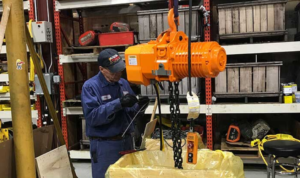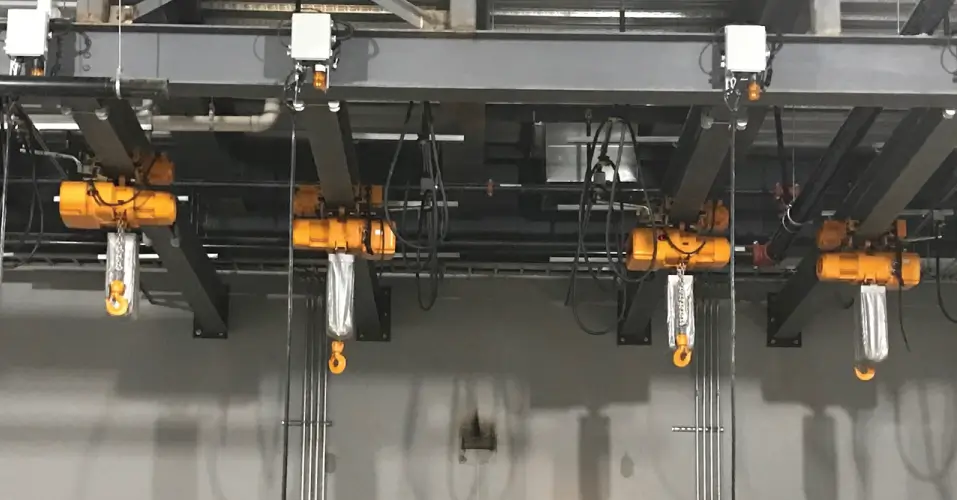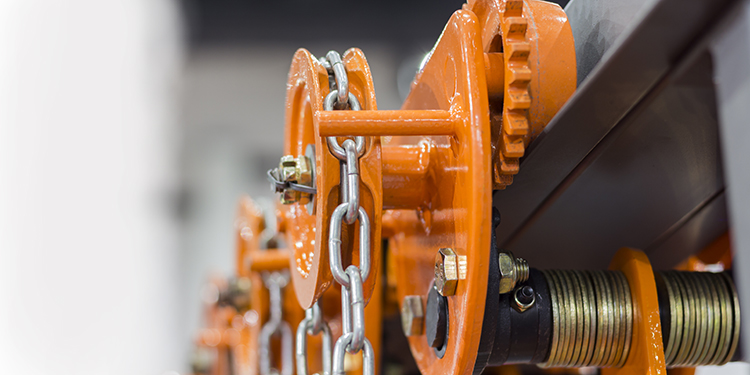
I see wasted budget and halted operations caused by faulty hoists. I feel that pain too. I help you find practical fixes to keep your electric chain hoist running.
Snippet Paragraph: Maintain and extend your hoist’s life by scheduling frequent checks, using correct lubrication, and performing proper load tests. Repair or replace worn parts early. Follow recommended storage guidelines.
I once faced costly downtime when our hoist failed mid-shift. That moment pushed me to investigate better maintenance practices. Let’s explore how I keep my hoist reliable.
[Table of Contents]
- Why Are Regular Inspections Important?
- How Does Lubrication Impact Hoist Performance?
- Which Load Testing Practices Prevent Breakdown?
- When Should You Replace Hoist Components?
- How to Store Your Hoist for Longevity?
- Why Consider Professional Servicing and Support?
- What Are Common Malfunctions and How to Avoid Them?
- People Also Ask: Common Questions
- Conclusion
Why Are Regular Inspections Important?
I always check my hoist before each shift. Small cracks or odd noises reveal big problems. Regular inspections keep equipment safe and save you from serious failures.
Inspections catch chain damage, hook wear, or electrical issues early. Look for bent links, worn brakes, and loose bolts. Track inspection results for trends that warn of bigger failures.

Routine inspection schedules vary. I follow daily visual checks, weekly mechanical reviews, and monthly in-depth tests.
- Daily Check: Scan for surface cracks. Listen for strange sounds.
- Weekly Check: Tighten loose bolts. Verify brake function.
- Monthly Inspection: Inspect motor performance. Assess chain elongation with calipers.
Key Inspection Statistics
| Statistic | Source/Context |
|---|---|
| 70% of overhead hoist failures from poor maintenance | Referenced in safety studies and OSHA reports (estimate) |
| Up to 80% of total hoist downtime is preventable | Industry research shows consistent checks reduce downtime |
| Annual load tests required in many regions | OSHA and local regulations |
| One hour of hoist downtime can cost $1,000+ in lost productivity | Internal estimates from facility case studies |
How Does Lubrication Impact Hoist Performance?
I remember a squeaky chain that nearly jammed during a production rush. Proper lubrication fixed that quickly and kept our process moving smoothly.
Good lubrication fights rust, reduces friction, and extends chain life. Under-lubrication leads to wear and overheating. Over-lubrication can attract grime. Follow manufacturer guidelines, and use recommended oil types.

I schedule weekly lubrication. I watch for:
- Chain dryness or corrosion
- Excessive oil buildup
- Metallic shavings or residue
Tips for Better Lubrication
- Use Manufacturer-Approved Lubricants: Avoid random oils.
- Apply Evenly: Focus on chain contact points.
- Inspect Components After Lubrication: Look for leaks or unusual residue.
Which Load Testing Practices Prevent Breakdown?
I have learned that load tests confirm a hoist’s real capacity. They also catch hidden flaws that routine checks miss.
Load tests ensure your hoist lifts safely at rated capacity. Conduct annual testing or follow regional guidelines. Document results to track equipment performance and keep your workplace compliant.

I plan load tests at least once a year. In heavy usage, I test biannually.
- Step 1: Inspect chain, hook, and motor before testing.
- Step 2: Lift the rated load slowly. Check for abnormal strain.
- Step 3: Record data. Keep a log for audits or legal requirements.
Table: Recommended Load Test Frequencies
| Usage Level | Testing Frequency |
|---|---|
| Light (Occasional) | Annually |
| Medium (Daily Use) | Semi-Annually |
| Heavy (Intense Use) | Quarterly or as needed |
When Should You Replace Hoist Components?
I replace parts before they fail. Doing this avoids bigger damage and keeps my crew safe.
Snippet Paragraph for H2: Replace hoist components if you see wear beyond recommended tolerances. Chains with elongation, hooks with cracks, or brakes with reduced grip all need prompt attention. Early swaps prevent accidents.

I monitor usage hours. Chains and hooks have rated lifespans.
- Chains: Replace if elongated beyond 5% or if cracks appear.
- Hooks: Check for tip spread and missing latch springs.
- Brakes: Listen for squeaks or slipping.
- Motors: Overheating or unexpected stops signal urgent repair.
How to Store Your Hoist for Longevity?
I learned the hard way that leaving a hoist in a damp corner leads to corrosion. Proper storage fights rust and premature wear.
Store hoists in dry, moderate environments. Cover them to block dust. Keep chains off the floor to prevent rust. Hang or secure your hoist to reduce impact risks.

I store my hoist on a rack. I keep humidity low.
- Clean It First: Wipe down any residue.
- Wrap or Cover: Shield from dust or moisture.
- Avoid Direct Sunlight: UV can degrade plastics or coatings.
- Use Proper Shelving: Prevent accidental knocks or topples.
Why Consider Professional Servicing and Support?
I once tried a quick DIY fix. I saved money but compromised safety. Professional help can be priceless.
Professionals spot hidden issues. They follow strict protocols, use certified tools, and ensure compliance with regulations. Their expertise lowers accident risks and extends your hoist’s operational life.

I schedule professional inspections at least once a year. Technicians measure chain pitch, calibrate brakes, and check electrical wiring. Their detailed reports boost our safety record and minimize surprises.
What Are Common Malfunctions and How to Avoid Them?
I see certain faults happen often. They can halt production and create hazards.
Chain jams, motor overheating, brake failures, and electrical faults are widespread. Regular checks, correct lubrication, and timely part replacement prevent these breakdowns. Simple habits keep your hoist trouble-free.
- Chain Jams: Occur when links bend or catch debris.
- Motor Overheating: Caused by heavy loads or poor ventilation.
- Brake Failures: Result from worn pads or misalignment.
- Electrical Faults: Often traced to damaged cables or control circuits.
Quick Tips
- Keep chains clean
- Watch load limits
- Service brakes regularly
- Inspect wiring for signs of wear
People Also Ask: Common Questions
How often should I lubricate the chain on my electric hoist?
I lubricate my chain weekly. Manufacturer guidelines may differ. Weekly lubrication prevents rust and noise. Over-lubrication can attract dust, so apply carefully.
What is the typical lifespan of an electric chain hoist?
Many hoists last over 10 years with good maintenance. Usage frequency, environment, and part quality affect lifespan. I track usage hours and stay ahead with scheduled servicing.
What safety checks should I perform daily?
I check the chain, hook, and motor. I listen for unusual sounds. I make sure controls respond quickly. These easy steps catch small problems before they escalate.
When should I schedule professional servicing?
I schedule once a year. You might need more frequent checks if your hoist runs daily or lifts near capacity often. Follow your manufacturer’s recommendations.
How can I tell if my hoist chain needs replacement?
Look for elongation, cracks, or corrosion. If it shows more than 5% stretch or any signs of damage, replace it immediately. Don’t wait for a sudden chain failure.
Are load tests necessary for my electric hoist?
Yes. Load tests verify that your hoist works correctly at its rated capacity. Many regions require annual tests. It’s an essential part of safety and compliance.
Conclusion
Good care and wise upkeep keep your electric chain hoist dependable and safe.


